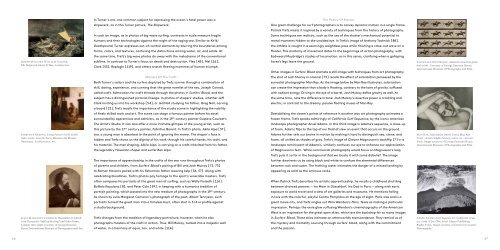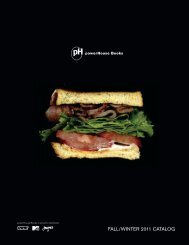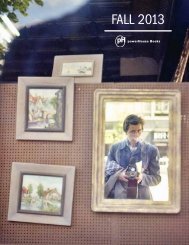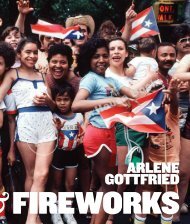This PDF is NOT the entire book - powerHouse Books
This PDF is NOT the entire book - powerHouse Books
This PDF is NOT the entire book - powerHouse Books
Create successful ePaper yourself
Turn your PDF publications into a flip-book with our unique Google optimized e-Paper software.
In Turner's era, one common subject for expressing <strong>the</strong> ocean's fatal power was a<br />
shipwreck, as in th<strong>is</strong> Turner picture, The Shipwreck.<br />
The Poetry Of Motion<br />
One great challenge for surf photographers <strong>is</strong> to convey dynamic motion in a single frame.<br />
Patrick Trefz meets it inspired by a variety of techniques from <strong>the</strong> h<strong>is</strong>tory of photography.<br />
Some techniques are real<strong>is</strong>tic, such as <strong>the</strong> use of <strong>the</strong> shutter's mechanical potential to<br />
reveal moments hidden to <strong>the</strong> unaided eye. In Trefz's image of Anthony Tashnick [88],<br />
<strong>the</strong> athlete <strong>is</strong> caught in a seemingly weightless pose while fin<strong>is</strong>hing a close-out wave on a<br />
floater. <strong>Th<strong>is</strong></strong> anatomy of movement dates to <strong>the</strong> beginnings of action photography, with<br />
Eadweard Muybridge's studies of locomotion, as in th<strong>is</strong> series, clarifying when a galloping<br />
horse's legs leave <strong>the</strong> ground.<br />
In such an image, as in photos of big-wave surfing, contrasts in scale measure fragile<br />
humans and <strong>the</strong>ir technologies against <strong>the</strong> might of <strong>the</strong> raging sea. Similar to Ke'Iki<br />
Deathpound, Turner expresses out-of-control elements by blurring <strong>the</strong> boundaries among<br />
forms, colors, and textures, confusing <strong>the</strong> d<strong>is</strong>tinctions among water, air, and solids. At<br />
<strong>the</strong> same time, Trefz's big wave photos do away with <strong>the</strong> melodrama of <strong>the</strong> conventional<br />
sublime. In contrast to Turner's focus on death and destruction, Flea [45], Mel [16],<br />
Clark [55], Replogle [119 ], and o<strong>the</strong>rs snatch fleeting moments of human triumph.<br />
Joseph Mallord William Turner,<br />
The Shipwreck (1805). ©Tate, London 2011.<br />
O<strong>the</strong>r images in Surfers' Blood animate a still image with techniques from art photography.<br />
Eadweard Muybridge, Animal Locomotion, plate<br />
626 (1878). Courtesy of George Eastman House,<br />
International Museum of Photography and Film.<br />
Masters Of The Craft<br />
Both Turner's sailors and <strong>the</strong> surfers depicted by Trefz survive through a combination of<br />
skill, daring, experience, and cunning that <strong>the</strong> great novel<strong>is</strong>t of <strong>the</strong> sea, Joseph Conrad,<br />
called craft. Admiration for craft threads through <strong>the</strong> photos in Surfers' Blood, and <strong>the</strong><br />
subject has a d<strong>is</strong>tingu<strong>is</strong>hed pictorial lineage. In photos of shapers' studios, whe<strong>the</strong>r Jeff<br />
Clark inviting us into h<strong>is</strong> workshop [54], or Jed Noll studying h<strong>is</strong> fa<strong>the</strong>r, Greg Noll, carving<br />
a board [22], Trefz recalls <strong>the</strong> importance of <strong>the</strong> studio scene in highlighting <strong>the</strong> nobility<br />
of finely skilled work and art. The scene can stage a famous painter before h<strong>is</strong> easel<br />
surrounded by apprentices and admirers, as in <strong>the</strong> 19 th century painter Gustave Courbet's<br />
The Art<strong>is</strong>t's Studio. It can also offer a more intimate glimpse of <strong>the</strong> young art<strong>is</strong>t, such as<br />
th<strong>is</strong> picture by <strong>the</strong> 17 th century painter, Fabritius Barent. In Trefz's photo, Akila Aipa [37],<br />
too, a young man <strong>is</strong> absorbed to <strong>the</strong> point of ignoring <strong>the</strong> viewer. The shaper's face <strong>is</strong><br />
hidden and Trefz shows us <strong>the</strong> dignity of h<strong>is</strong> work through h<strong>is</strong> careful hands, h<strong>is</strong> tools, and<br />
h<strong>is</strong> material. The man shaping, Alkila Aipa, <strong>is</strong> carrying on a craft inherited from h<strong>is</strong> fa<strong>the</strong>r,<br />
<strong>the</strong> legendary Hawaiian shaper and surfer Ben Aipa.<br />
The shot of Josh Mulcoy in a barrel [73] recalls <strong>the</strong> effect of solarization pioneered by <strong>the</strong><br />
surreal<strong>is</strong>t photographer Man Ray. As <strong>the</strong> image below by Man Ray illustrates, solarization<br />
can create <strong>the</strong> impression that a body <strong>is</strong> floating, contrary to <strong>the</strong> laws of gravity, suffused<br />
with radiant energy. Driving in <strong>the</strong> eye of a barrel, Josh Mulcoy defies gravity as well. At<br />
<strong>the</strong> same time, note <strong>the</strong> difference in tone: Josh Mulcoy's assertive power <strong>is</strong> crackling and<br />
electric, in contrast to <strong>the</strong> dreamy, passive floating muses of Man Ray.<br />
Destabilizing <strong>the</strong> viewer's points of reference <strong>is</strong> ano<strong>the</strong>r way art photography animates a<br />
frozen frame. Trefz speaks admiringly of California Surf Sequence, by <strong>the</strong> iconic American<br />
landscape photographer Ansel Adams. In th<strong>is</strong> third image in Adams's sequence, a close-up<br />
of foam, Adams flips to <strong>the</strong> top of our field of view an event that occurs on <strong>the</strong> ground.<br />
Adams fur<strong>the</strong>r sets our brains in motion by making it hard to d<strong>is</strong>tingu<strong>is</strong>h sea, stone, and<br />
foam, all unified as shades of gray. Trefz's image of Cheyne Magnusson's backflip [7] in a<br />
landscape remin<strong>is</strong>cent of Adams's, similarly confuses our eye to enhance our appreciation<br />
of Magnusson's feat. While commercial photography would focus on Magnusson's leap,<br />
Trefz puts it so far in <strong>the</strong> background that we locate it with some d<strong>is</strong>belief. The image<br />
fur<strong>the</strong>r d<strong>is</strong>orients us by using black and white to confuse <strong>the</strong> elemental differences<br />
between rock and water. The frothing water intimates <strong>the</strong> danger of a m<strong>is</strong>sed landing by<br />
appearing as solid as <strong>the</strong> ominous rocks.<br />
Fabritius Barent, Young Painter in H<strong>is</strong> Studio<br />
(1655–1660). Louvre, Par<strong>is</strong>, Réunion des Musées<br />
Nationaux | Art Resource, ny.<br />
May Ray, Solarization (1929). ©2011 Man Ray<br />
Trust | Art<strong>is</strong>ts Rights Society (ars), ny /adagp,<br />
Par<strong>is</strong>. Image courtesy of George Eastman House,<br />
International Museum of Photography and Film.<br />
The importance of apprenticeship in <strong>the</strong> crafts of <strong>the</strong> sea runs throughout Trefz's photos<br />
of parents and children, from Surfers' Blood's pairing of Bill and Josh Mulcoy [72, 73]<br />
to Ramon Navarro paired with h<strong>is</strong> f<strong>is</strong>herman fa<strong>the</strong>r weaving kelp [56, 57]. Along with<br />
celebrating bloodlines, Trefz's photos pay homage to <strong>the</strong> sport's venerable masters. Trefz<br />
often composes h<strong>is</strong> portraits of <strong>the</strong> great men of surfing, such as Wally Fro<strong>is</strong>eth [116],<br />
Buffalo Keaulana [8], and Peter Cole [59], in keeping with a human<strong>is</strong>t tradition of<br />
portrait painting, which passed into <strong>the</strong> new medium of photography in <strong>the</strong> 19 th century.<br />
As shown by Julia Margaret Cameron's photograph of <strong>the</strong> poet, Albert Tennyson, such<br />
portraits turned <strong>the</strong> great man into a timeless bust, often shot in 3/4 or profile against<br />
a studio background.<br />
When Patrick Trefz describes h<strong>is</strong> art<strong>is</strong>tic apprenticeship, he recalls a childhood shuttling<br />
between divorced parents — h<strong>is</strong> Mom in Düsseldorf, h<strong>is</strong> Dad in Par<strong>is</strong> — along with early<br />
exposure to world travel and a slew of art galleries and museums. He mentions falling<br />
in love with <strong>the</strong> colorful, playful Centre Pompidou at <strong>the</strong> age of eight. Par<strong>is</strong> was and <strong>is</strong> a<br />
great movie city, and Trefz singles out Wim Wenders's Par<strong>is</strong>, Texas as making a particular<br />
impression. Perhaps <strong>the</strong> eerie glow suffusing Wenders's cinematography of <strong>the</strong> American<br />
West <strong>is</strong> an inspiration for <strong>the</strong> great open skies, which are <strong>the</strong> backdrop for so many images<br />
in Surfers' Blood. These skies intimate an o<strong>the</strong>rworldly transcendence. They remind us of<br />
<strong>the</strong> mystery and mortality coursing through surfers' blood, along with <strong>the</strong> commitment<br />
and <strong>the</strong> passion.<br />
Julia Margaret Cameron, Illustration to Alfred,<br />
Lord Tennyson's “Idylls of <strong>the</strong> King” and O<strong>the</strong>r Poems,<br />
London: 1875. (1865). Courtesy of George Eastman<br />
House, International Museum of Photography and Film.<br />
Trefz diverges from <strong>the</strong> tradition of legendary portraiture, however, when he also<br />
photographs masters of <strong>the</strong> craft in action. Thus, Bill Mulcoy, tucked into a majestic wall<br />
of water, in a harmony of aqua, tan, and white [114].<br />
Ansel Adams, Surf Sequence iii, California Coast<br />
(ca. 1940). ©2011 The Ansel Adams Publ<strong>is</strong>hing<br />
Rights Trust. Image courtesy of Center for Creative<br />
Photography.<br />
66 67











